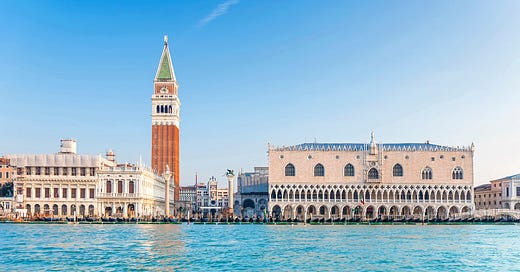Now that the United States has exited one of the most tumultuous and significant presidential elections in modern history, I wanted to take us on a history field trip. Our destination? The Venetian Republic, circa 1350. My interest in Venice keeps growing. My iTalki instructor – Elena Ribaudo – hails from Mestre, a city across the lagoon from Venice, and she continues to share the alluring beauty of that civilization with me.
If you’re really serious about learning Italian and want to understand Italian culture, art, history, and music, Elena Ribaudo is the instructor for you. Check out her Italian Inspirations Substack. Better yet, schedule a lesson with her on iTalki. Start your Italian journey today with someone who knows Italy.
In a time when monarchs ruled much of Europe, Venice was a republic. Today, we would say it was a political outlier of its time. In his beautifully written book, Venice: A Maritime Republic, Frederic Lane explores the Republic of Saint Mark (the other name for the Venetian empire) in its various dimensions. Lane writes that Venice was an oligarchy run by the city's leading families.
The republic’s political pyramid looked like this:
Unfortunately, I do not have time to describe the Venetian polity in detail here. Suffice it to say, each of these political units existed in a dynamic and fluid relation to the others, somewhat akin to the relations between America’s three branches of government. Naturally, my analysis here is a simplification, though the checks and balances built into each system are what I find most interesting.
At the top sat the Doge, the chief executive officer of the Venetian empire. The Doge was not a king. A great Doge, like a successful American president, was someone who recognized the limits of the office (explicitly stated in the oath each Doge signed at the start of their term) and could negotiate with each branch of the government, balancing the republic’s many competing interests. The election of a Doge was thus crucial to the stability and longevity of the Venetian way of life, and it needed to be done in a transparent and unbiased way.
Creating a functioning republic in northern Italy during the Renaissance was no small task. Powerful families dominated the political landscape in many city-states, the Medici in Florence being a striking example. The risk of internecine warfare was real. At that time, the most dreaded thing to befall a city – other than an outbreak of the plague – was to see its once peaceful streets filled with rival clans battling each other for political control. Venice largely avoided this fate. One of the reasons for its stability was the striking process the republic followed to elect a Doge. Lane (p. 111) summarizes that election process as follows:
From the Great Council there was chosen by lot 30; the 30 were reduced by lot to 9; the 9 named 40; the 40 were reduced by lot to 12; the 12 named 25; the 25 were reduced by lot to 9; the 9 named 45; the 45 were reduced by lot to 11; the 11 named 41; the 41 nominated the doge, for approval by the Assembly
After an election like this, no one could claim election fraud or bias. The process is notable for its use of downsampling, the reduction of a sample through chance. In this case, the Venetians cast lots to reduce the size of each group after it had been selected by humans. The selection of a Doge was, therefore, a dance between choice and chance. At each step, human desires and emotions pushed the process forward, only to then be shaped and molded by randomness.
What I find most interesting about this election system is its balance and transparency. Every faction, all the important families, had a place at the table, with lots deciding when each voice was to be heard. The election itself was open; at least, I have found nothing in the research that says otherwise. All of Venice knew who was participating in each round. Was the system perfect? No, no system ever is. Even so, I don’t see how anyone could have “gamed” a Venetian election. Status and money indeed had their influence. But I doubt anyone could say, as Mark Twain once did of us, that they “had the best government money could buy.”
I end today’s post with a question. What might happen if America adopted the Venetian way of choosing a chief executive? Just imagine. No multi-year campaigns. No multi-billion dollar election spending sprees. No mud-slinging at rallies and debates. This sounds pretty nice unless you’re one of those rare political animals who relishes the political fray. Herein lies the value of historical knowledge. With it, a range of creative responses to common human concerns – the selection of a leader, for example – come into view. A deep view of history opens up alternatives. It supports counterfactual thinking, a process whereby we imagine how things might be, given how they once were. For that reason, the unique Venetian political system still has something important to say to us today.





